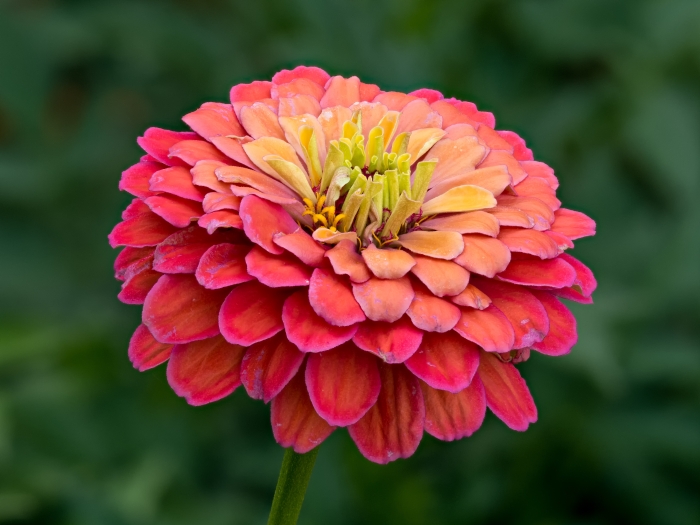Youth-And-Age
(Zinnia elegans)
Youth-And-Age (Zinnia elegans)
/
/

Ermell
CC BY-SA 4.0
Image By:
Ermell
Recorded By:
Copyright:
CC BY-SA 4.0
Copyright Notice:
Photo by: Ermell | License Type: CC BY-SA 4.0 | License URL: https://creativecommons.org/licenses/by-sa/4.0 | Uploader: Ermell | Publisher: Wikipedia Commons |



















































































Estimated Native Range
Summary
Zinnia elegans, commonly known as Youth-And-Age, is an annual herb native to scrub and dry grasslands in Mexico and Central Mexico. It is a member of the daisy family and is characterized by its vibrant, showy flowers and ease of cultivation. Zinnia elegans typically grows to a height of 1-3 feet and features solitary flower heads that can be up to 5 cm (2 in) across. The flowers come in a variety of colors, including pink, red, purple, orange, and white, with the purple ray florets often surrounding black and yellow central discs. The blooming period extends throughout the summer months, providing a long-lasting display of color.
Zinnias are highly valued for their bright, long-lasting flowers and are commonly used in border plantings, cut flower gardens, and as a colorful addition to vegetable gardens. They are easy to grow from seed and are known for attracting butterflies and other pollinators. Zinnias prefer well-drained, loamy soil and thrive in full sun, making them suitable for sunny garden spots. While they are drought-tolerant, they benefit from regular watering during prolonged dry spells. Zinnia elegans cultivars come in a wide range of sizes and flower forms, including single, semi-double, and double-flowered types. Some popular cultivars include ’Envy’ with its unique green flowers, ’Queen Red Lime’ with red and lime bicolor blooms, and ’Candy Cane Mix’ with striped petals. Potential problems include powdery mildew and leaf spot, particularly in humid conditions. To minimize disease risk, provide good air circulation around the plants and avoid overhead watering. Zinnia elegans is not typically invasive in its native range but can become a problem in some regions outside of its native habitat; gardeners should check local guidelines before planting.CC BY-SA 4.0
Zinnias are highly valued for their bright, long-lasting flowers and are commonly used in border plantings, cut flower gardens, and as a colorful addition to vegetable gardens. They are easy to grow from seed and are known for attracting butterflies and other pollinators. Zinnias prefer well-drained, loamy soil and thrive in full sun, making them suitable for sunny garden spots. While they are drought-tolerant, they benefit from regular watering during prolonged dry spells. Zinnia elegans cultivars come in a wide range of sizes and flower forms, including single, semi-double, and double-flowered types. Some popular cultivars include ’Envy’ with its unique green flowers, ’Queen Red Lime’ with red and lime bicolor blooms, and ’Candy Cane Mix’ with striped petals. Potential problems include powdery mildew and leaf spot, particularly in humid conditions. To minimize disease risk, provide good air circulation around the plants and avoid overhead watering. Zinnia elegans is not typically invasive in its native range but can become a problem in some regions outside of its native habitat; gardeners should check local guidelines before planting.CC BY-SA 4.0
Plant Description
- Plant Type: Herb
- Height: 1-3 feet
- Width: 0.8-1 feet
- Growth Rate: Moderate
- Flower Color: Cream, Green, Orange, Pink, Purple, Red, White, Yellow
- Flowering Season: Summer, Fall
- Leaf Retention:
Growth Requirements
- Sun: Full Sun
- Water: Medium
- Drainage: Medium
Common Uses
Bee Garden, Bird Garden, Border Plant, Butterfly Garden, Deer Resistant, Drought Tolerant, Hummingbird Garden, Potted Plant, Rabbit Resistant, Salt Tolerant, Showy Flowers, Street Planting
Natural Habitat
native to scrub and dry grasslands in Mexico and Central Mexico
Other Names
Common Names: Youth And Old Age, Garden Zinnia, Zinnia, Youth-And-Old-Age, Common Zinnia, Elegant Zinnia, Zinnie, Garten-Zinnie, Pracht-Zinnie, Zinnia Élégant
Scientific Names: , Zinnia elegans, Zinnia linearis, Zinnia violacea, Crassina elegans, Zinnia elegans var. coccinea, Zinnia elegans var. elegans, Zinnia elegans var. violacea, Crassina linearis, Zinnia australis
GBIF Accepted Name: Zinnia elegans Jacq.